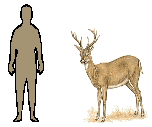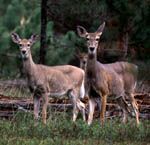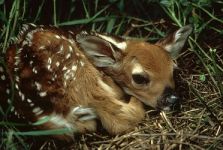OHIO'S STATE
ANIMAL - THE
WHITE-TAILED DEER
In
February of 1988, Governor
Richard F. Celeste signed
House Bill 312 making the
white-tailed deer Ohio’s state
animal. The bill was
introduced by State
Representative E.J. Thomas at
the request of Cheryl
Phillips’ fourth grade
students from Worthington
Estates Elementary School.
Among a number of reasons
given supporting the white-
tailed deer, the students said
the term “buck” used for male
deer would fit in with another
state symbol, the buckeye
tree, and Ohio’s nickname,
“the Buckeye State.” . The
white-tailed deer is the
largest game animal in Ohio
and can be found in all
of Ohio's 88 counties,
although about 80 percent of
the herd lives in hilly
eastern Ohio.
Here is
the section of the Ohio
Revised Code declaring the
state animal:
5.032 State animal - The
animal, Odocoileus
virginianus, commonly known as
the white-tailed deer, is the
official animal of the state.
Naming the white-tailed deer
as the official animal of the
state does not relieve the
division of wildlife of its
duty to manage the deer
population and its
distribution. (1988 H 312,
eff. 5-11-88)

White-tailed deer
measure about 3 to 3˝ feet
tall at the shoulder and the
largest bucks (male deer) can
weigh 400 lbs. The
White-Tailed Deer is a
long-legged, fast-moving
mammal. When it's
startled, it raises its tail
like a flag, which is white on
the underside.Whitetail deer
are nervous and shy. They wave
their tails characteristically
from side to side when they
are startled and fleeing.
They may bound at speeds
of up to 30 miles per hour
through a forest.
Whitetail deer are also good
swimmers and often enter large
streams and lakes to escape
predators or insects or to
visit islands. Their home
ranges are generally small,
often a square kilometer or
less. Whitetail deer do not
migrate to a winter range but
yard up in their own
territories during heavy snow.
 
Only the bucks
have antlers, which are
branched and shed each year,
then re-grow. A female deer is
a doe and they usually travel
in small herds with their
young. Fawns are usually born
in May or June. Whitetail does
are painstakingly careful to
keep their offspring hidden
from predators. When foraging,
females leave their offspring
in dense vegetation for about
four hours at a time. While
waiting for the female to
return, fawns lay flat on the
ground with their necks
outstretched, well camouflaged
against the forest floor.
Fawns withhold their feces and
urine until the mother
arrives, at which point she
eats whatever the fawn voids
to deny predators any sign of
the fawn.

The genus and species
of the White-Tailed Deer are
Odocoileus virginianus. This
deer is found over most of
North and Central America and
northern parts of South
America. It lives in deciduous
forests, conifer forests,
rainforests, grasslands, farm
land, marshes, and even
deserts.White-Tailed Deer
are herbivores
(plant-eaters) who spend most
of the day eating leaves,
grass, bark, acorns, and buds
and twigs of maple, sassafras,
poplar, aspen and birch (to
name a few), as well as many
shrubs. Conifers are
often utilized in winter when
other foods are scarce.
Whitetail deer are
crepuscular, feeding mainly
from before dawn until several
hours after, and again from
late afternoon until
dusk. Their life span in
the wild is 10 years, but
whitetail deer have lived up
to 20 years in captivity.
Other states
that has named the
White-tailed deer (Odocoileus
virginianus) as their official
state mammal and/or animal:
Arkansas; Illinois; Michigan;
Mississippi; Nebraska; New
Hampshire; Ohio; Oklahoma;
Pennsylvania; South Carolina;
Wisconsin
Common
names are white-tailed deer;
whitetail deer; Columbian
white-tailed deer; Key deer;
Coues deer; Texas white-tailed
deer; sandhill deer; common
deer; jumping deer;
flag-tailed deer; bannertail;
long-tailed deer; Virginia
white-tailed deer; Virginia
deer
|
|






